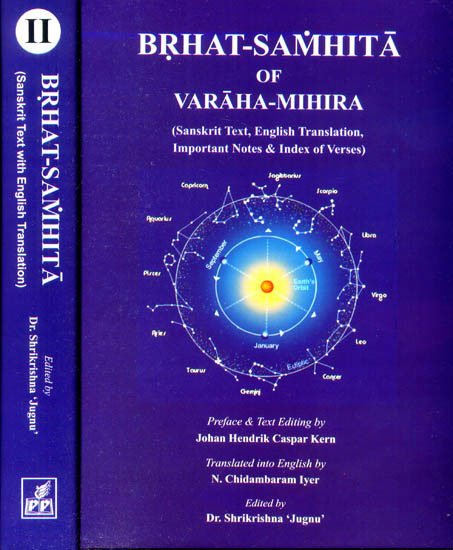Brihat Samhita
by N. Chidambaram Iyer | 1884 | 135,584 words | ISBN-13: 9788171104215
This page describes the course of mars (bhauma-cara) which is the sixth Chapter of the English translation of the Brihat-samhita. This work, written by Varahamihira in the 6th century, is classified as jyotisha literature, also known as Indian astronomy. It contains however, also content regarding astrology, palmistry, agriculture, gardening, perfumes, medicines and various other encyclopedic topics.
Chapter 6 - On the course of Mars (bhauma-cāra)
[Sanskrit text for this chapter is available]
The retrograde motion of Mars (bhauma) is of five kinds known technically as—1. Uṣṇa, 2. Aśrumukha, 3. Vyāla, 4. Rudhirānana and 5. Asimusala.[1]
1. If the Mars should begin to retrograde from the 7th, 8th or 9th constellation from that in which he reappears[2] after his conjunction with the Sun, persons who live by fire will be afflicted with disease.
2. If Mars should begin to retrograde from the 10th, 11th or 12th constellation from that of his reappearance, such retrograde motion is known as aśrumukha: when Mars should re-appear after his next conjunction with the Sun, juice will be injured and there will be disease and drought.
3. If he should begin to retrograde from the 13th or 14th constellation from that of his reappearance, such retrograde motion is known as vyāla: when he should disappear before his next conjunction with the Sun, wild boars and fierce animals will be afflicted with distress.
4. If Mars should begin to retrograde from the 15th or the 16th constellation from that of his reappearance, such retrograde motion is known as rudhirānana; at the time of such reappearance mankind will be afflicted with disease in the face and with various fears, but there will be prosperity in the land.
5. If he should begin to retrograde from the 17th or the 18th constellation from that of his reappearance such retrograde motion is known as Asimusala; when Mars is in his reretrograde motion, bands of robbers will be afflicted with distress and there will be drought and wars in the land.
6. If Mars (bhauma) should re-appear in the constellation of Pūrvaphālguni (sacred to Bhāga) or in that of Uttaraphālguni (sacred to Āryama), retrograde in the constellation of Uttarāṣāḍha (sacred to Viśvedeva) and disappear in the constellation of Rohiṇī (sacred to Bhauma), he will afflict the three worlds with miseries.
7. If Mars, after his re-appearance in the constellation of Śravaṇa, should retrograde in that of Puṣya, anointed monarchs will be afflicted with miseries; those countries and those persons will suffer in whose Nakṣatra, Mars should begin to reappear.[3]
8. If Mars should pass through the middle of the constellation of Maghā and retrograde back through the same, the ruler of the Pāṇḍya country will perish and mankind will suffer from wars and drought.
9. If Mars should, after cutting through the constellation of Maghā, approach the middle of Viśākhā, there will be famine in the land; if he should cut through the constellation of Rohiṇī, there will be fearful deaths in the land.
10. If Mars should pass to the south of the constellation of Rohiṇī, rulers will suffer, prices will rise and there will be little rain; if Mars should appear enveloped in smoke or with a pointed flame, the people of Pāriyātra[4] will perish.
11. If Mars should pass through the constellations of Rohiṇī, Śravaṇa, Mūla, Uttara Phālguni, Uttarāṣādha, Uttarabhādrapada and Jyeṣṭhā, he will destroy clouds charged with rain.
12. If Mars should pass through the constellations of Śravaṇa, Maghā, Punarvasu, Hasta, Mūla, Pūrvabhādrapada, Aśvini, Viśākhā and Rohiṇī, there will be prosperity in the land.
13. If Mars should appear with a large and clear disc or red like the flower of Kiṃśuka (Butea Frondosa) or of Aśoka (Jonesia Aśoka Roxb) or of clear and fine rays or like molten gold or if he should pass through the northern path,[5] rulers will be happy and there will be prosperity in the land.
Footnotes and references:
[1]:
These terms are explained in the subsequent stanzas.
[2]:
Mars is said to disappear when within 17 degrees from the Sun and to reappear when beyond it.
[3]:
For the Nakṣatra of a country, see chapter on Kūrma Vibhāga.
[4]:
Pāriyātra: the central or the western portion of the Vindhya chain which skirts the province of Malwa.
[5]:
Northern path: according to Garga, the nine constellations from Bharaṇi to Makhā constitute the northern path; the nine from Pūrvaphālgunī to Mūla constitute the middle path and the nine from Pūrvāṣādha to Aśvinī constitute the southern path.
